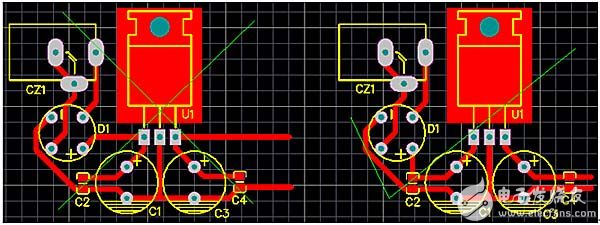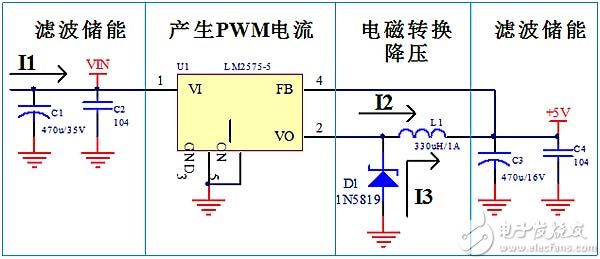The power circuit is an important part of an electronic product. The design of the power circuit is directly related to the performance of the product. The power circuits of our electronic products mainly include linear power supplies and high frequency switching power supplies. In theory, the linear power supply is how much current the user needs, how much current is required at the input; the switching power supply is how much power the user needs, and how much power is supplied to the input.
Linear power supply
The linear power supply device works in a linear state, such as our commonly used voltage regulator chips LM7805, LM317, SPX1117 and so on. The following figure is the schematic diagram of the LM7805 regulated power supply circuit.

Figure 1 Schematic diagram of linear power supply
As can be seen from the figure, the linear power supply is composed of functional components such as rectification, filtering, voltage regulation, and energy storage. At the same time, the general linear power supply is a series regulated power supply, and the output current is equal to the input current. I1=I2+I3, I3 is a reference. At the end, the current is small, so I1≈I3. Why do we talk about current, because the width of each line is not designed casually in PCB design, it is determined according to the current between the component nodes in the schematic diagram (please check the PCB design copper and platinum thickness, line width and Current relationship table)). The current flow and current flow are to be clarified, and the board is just right.
When designing the PCB, the layout of the components should be compact. To make all the connections as short as possible, it is necessary to lay out the components and traces according to the functional relationship of the schematic components. In this power supply diagram, it is first rectified, refiltered, filtered, and then stabilized. After the voltage is stabilized, it is the storage capacitor. After flowing through the capacitor, it is used to power the circuit behind. Figure 2 is a PCB diagram of the above schematic, the two diagrams are similar. The left and right diagrams are a little different. The power supply on the left is rectified and directly goes to the input pin of the regulator chip. Then it is the voltage regulator capacitor. The filter effect from the capacitor is much worse. There are also problems. The picture on the right is a better picture. We must not only consider the flow direction of the positive power supply, but also must consider the reflow problem. Generally speaking, the positive power supply line and the ground return line should be as close as possible to each other and close to each other.

Figure 2 linear power PCB diagram
When designing a linear power supply PCB, you should also pay attention to the heat dissipation problem of the power supply chip of the linear power supply. How does the heat come from? If the front end voltage of the voltage regulator chip is 10V, the output terminal is 5V, and the output current is 500mA, then the voltage regulator chip There is a voltage drop of 5V, and the generated heat is 2.5W. If the input voltage is 15V, the voltage drop is 10V, and the generated heat is 5W. Therefore, we need to leave enough space for the heat dissipation. Cooling space or a reasonable heat sink. Linear power supplies are generally used when the voltage difference is relatively small and the current is relatively small. Otherwise, use a switching power supply circuit instead.
High frequency switching power supply
The switching power supply uses high-speed conduction and cut-off through the circuit control switch tube to generate the PWM waveform. Through the inductor and the freewheeling diode, the electromagnetic voltage is used to regulate the voltage. The switching power supply has high power, high efficiency and low heat generation. The circuits we generally use are: LM2575, MC34063, SP6659, etc. In theory, the switching power supply is equal in power at both ends of the circuit, the voltage is inversely proportional, and the current is inversely proportional.

Figure 3 LM2575 switching power supply circuit schematic
When designing a switching power supply PCB, the points to be noted are: the introduction point of the feedback line, and the freewheeling diode is for whom the freewheeling. As can be seen from Figure 3, when U1 is turned on, current I2 enters inductor L1. The characteristic of the inductor is that the current cannot flow suddenly in the inductor, and it cannot suddenly disappear. There is a time course when the current changes in the inductor. Under the action of the pulse current I2 flowing through the inductor, part of the electric energy is converted into magnetic energy, and the current is gradually increased. At a certain time, the control circuit U1 turns off I2, and the current cannot be suddenly disappeared due to the characteristics of the inductor, and the diode acts at this time. It replaces the current I2, so it is called a freewheeling diode. It can be seen that the freewheeling diode is used for the inductor. The freewheeling current I3 starts from the negative end of C3 and flows into the positive end of C3 through D1 and L1. This is equivalent to a water pump that uses the energy of the inductor to increase the voltage of capacitor C3. There is also a feedback line introduction point problem for voltage detection, which should be fed back after filtering, otherwise the output voltage ripple will be larger. These two points are often overlooked by many PCB designers. They think that the same network is not the same. The actual connection is different, and the performance impact is very big. Figure 4 is the PCB diagram of the LM2575 switching power supply. Let's see what is wrong with the wrong picture.

Figure 4 LM2575 switching power supply PCB diagram
Why do we want to explain the principle of the schematic in detail, because the schematic contains a lot of PCB information, such as the access point of the component pins, the current of the node network, etc., to see the schematic, PCB design is not a problem. The LM7805 and LM2575 circuits represent the typical layout circuit of the linear power supply and the switching power supply. When the PCB is used, the layout and wiring of the two PCB layouts can be directly performed. The products are different, and the circuit boards are different, and adjusted according to actual conditions.
The principle of the power supply circuit and the layout method are the same, and each electronic product cannot be separated from the power supply and its circuit. Therefore, the two circuits are learned, and the others are also known. Chest.
600V DC Electronic Load System
600V DC Electronic Load System have options for 39600W/52800W/66000W , the highest power will be 2400A.It supports list function. RS232, RS485 and USB is the standard communication interfaces. LAN&GPIB communication card is optional. This series DC Electronic Load can be applied to battery discharge, DC charging station and power electronics and other electronics products.BTW, expect 600V DC Electronic Load System can cover 200V DC Electronic Load System, also it can have high voltage options for 1200V DC Electronic Load System.
Kinly check below features for your reference:
â— Flippable front panel and color touch screen allow convenient access and operation
â— Provides four kinds of basic working mode such as CV/CC/CR/CP, and CV+CC/CV+CR/CR+CC complex operating modes
â— Adjustable current slew rate, adjustable CV loop speed
â— Ultra high precision voltage & current measurement
â— 50kHz high-speed CC/CR dynamic mode
â— 500kHz high-speed voltage and current sampling rate
â— Timing & discharging measurement for batteries
â— Short circuit test mode
â— Auto mode function provides an easy way to do complicated test
â— V-monitor/I-monitor
â— Full protection: OCP, OPP, OTP, over voltage and reverse alarm
â— Front panel USB interface supports data import and export
â— Using standard SCPI communication protocol
â— Smart fan control with lower noise and better for environment
600V list mode DC E-load, 600V dynamic mode DC electronic load, 500kHz sampling rate DC electronic load
APM Technologies Ltd , https://www.apmpowersupply.com
